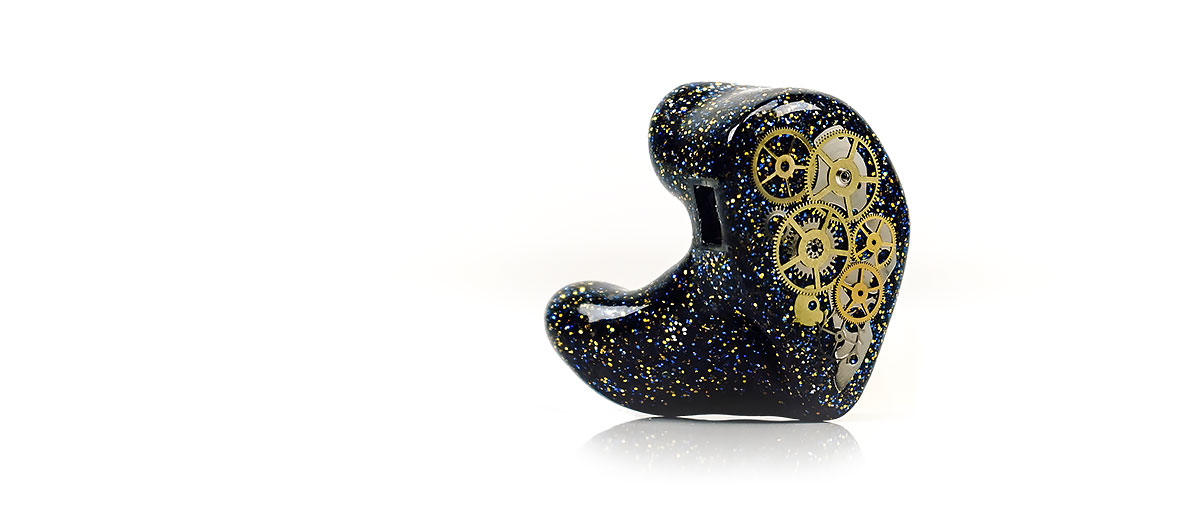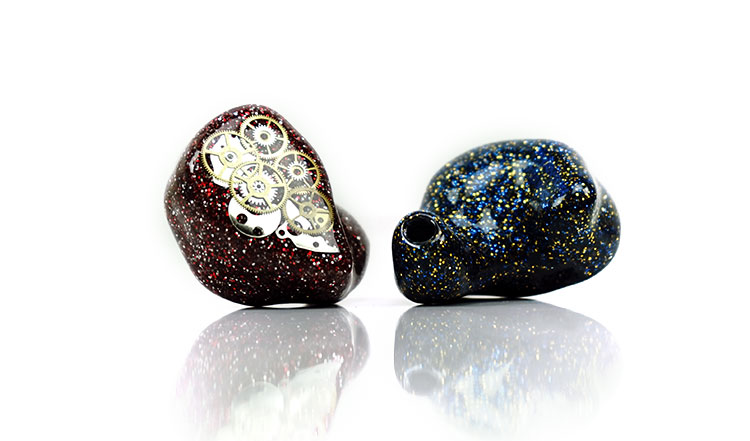Meet The Phantom
Design
Despite offering an online design Empire Ears is flexible enough to deal with your own particular design preferences. After a few emails, we came up with glitter red and blue shell design adorned with classic clock face parts. Possibly not the most original of requests but if done correctly can be quite eye-catching.
The beauty of this build is the complexity of the clock face design they actually put into the Phantom unit. It is very slightly aged looking which I prefer to a super clean faceplate.
The layering of the cogs and wheels is exquisitely done and complements the glitter finish on each side. The shell colors look fairly solid in tone as opposed to translucent which in turn allows the glitter to sparkle a bit more.
Materials
The Phantom shell is made of customized and polished acrylic apart from the clock face parts which are a very thin metal composite. Empire Ears finishing does not have them too deep-set but the acrylic finish over them is thick enough. Going over them carefully I have yet to spot any blemishes, bubbles, or uneven finishing.
Horn Design Bore
The Phantom is a multi-bore design. However, the bores are terminated much deeper into the chamber and not right at the tip of the nozzle. This termination point is where the “horn design” essentially starts.
The large open bore allows Empire Ears to fine-tune and develop the readily mixed sound before it leaves the chamber and into the bore. In doing so, they are able to tweak the Phantoms’ high-frequency extension a little further than what is possible with a traditional individual tubed bore design using the same drivers.
Cables & Connectors
Connectors
The Phantom uses a standard recessed socket 2-pin 0.78mm connection system. It should be just fine for the majority of aftermarket cables of which an excellent one is included as the stock cable. As far as I am aware Empire Ears does not offer any MMCX variations on its product lineup.
There is a sizeable gap in the socket to fit most cable barrel heads but on this one, the sockets are just leaning slightly to the outside. This means in practice you have to guide it with a bit more caution than most as it will not immediately slot right in.
I also tend to find EA cable pins to be a little on the large side meaning the insertion can be a little stiff. Get the angle and pressure wrong and you could end up bending the pins.
Stock Cable
Outside of Westone, Empire Ears are one of only a few monitor manufacturers that I know off that ships with a quality aftermarket cable as stock. Westone tapped ALO Audio with their Reference 8 MMCX cable, UE with Linum, and now Empire Ears with the excellent Ares II from Effect Audio.
Effect Audio Ares II
This is a fantastic cable out of the box with a pliant, low microphonic build quality and an attractive and very supple translucent PVC jacket. The braided wire is a 26AWG 4-wire multi-size UPOCC Litz copper strand geometry.
It is terminated with a hefty aluminum and gold-plated right-angle 3.5mm TRS jack and EA’s chrome finished metal barrels for the 2-pin connectors on the other end. The Y-split is a beautifully branded chrome aluminum barrel with a carbon fiber print.
On the market alone this is being sold for $149.90 and it is worth every penny. You will get a smooth coppery sound with a slightly attenuated high end and good body on the low-end. It is a massive step up in terms of dynamic range compared to Plastics One variants CIEMs normally come packaged with.
Comfort & Seal
The Phantom acrylic builds are fairly standard and do not use any fancy heat reactant materials such as the Westone ES80’s flex material on their nozzle tips. Thus there is a bit more immediate pressure on the Phantom fit compared to the Westone fit though this can be somewhat anecdotal as it depends on the molds you send in the first place and how accurate they are.
Overall, I find the Phantom fit to be a little bit thicker on the nozzle than either the Vision Ears VE5, 64 Audio’s A6, or the UE18+. The main shell is not as deep as the UE18+ Pro so it does not stick out as much.
However, the horn design and slightly less detailed nozzle shape mean the Phantom is using a bit more pressure to finalize the seal than minute shaping accuracy. It is still very comfortable but you are just more aware of it in your ear than something like the Westone ES80.
The seal is impeccable with fantastic attenuation on background noise. I rate the isolation (and silence) as slightly better than both the UE18+ Pro and the APEX-infused A6 from 64 Audio.
Sound Impressions
Prelude
Ironically, after extolling the virtues of how great the Ares II cable is I have to say this may not be the correct tonal match to show off the real potential of the Phantom.
That is not to say it is a bad cable, far from it. I would shudder to think how limp and lifeless it could sound with a generic 4-wire OFC. Rather the copper tones of the Ares II soften the sound of an already smooth-sounding monitor.
The Phantom does react positively to upgrading to 8-wire variants such as the Ares II 8-wire and the high-end Janus Dynamic. It also has an excellent presentation with very high-performing 4-wire builds such as the Thor II or the Leonidas II. I would suggest you try those cables out to hear the Phantom at its maximum potential.
Summary
The Phantom presentation is reasonably u-shaped but with a greater bias to the bass to lower mid-range in terms of body and presence. Interestingly, it does not have that classic 1-2k bump you tend to find in these types of tunings. The Phantom actually stays pretty neutral and linear in its response from 1-3k so higher pitching vocal presence is not terribly forward sounding.
The tone is rich to my ear and errs to the slightly warm side due to its thick sounding low-end and elevated lower midrange. Instrumental timbre, particularly lower-pitched instruments have outstanding weight, texture, and detail.
Treble on the Phantom is tastefully done with a staggered 4-8k elevation that focuses more on delivering a great body and a refined smoother attack with a little sparkle rather than outright energy and liveliness.
Cable choice does play a role in how much detail shines through on the Phantom. I tend to find moving up to 8-wire here is crucial as the Ares II treble is more muted and less airy sounding. 8-wire builds such as the Janus Dynamic really open up the clarity levels and deliver much better headroom on the Phantom.
Staging
The Phantom does not cast a particularly huge soundstage though its level of depth is very good. It is perhaps neutral to slightly intimate in part with that forward lower midrange and slightly relaxed upper treble. You never get the feeling you are that far back from the stage but with that neutral vocal presence, you are not exactly in the thick of it either.
However, the Phantom does remarkably well with imaging, delivering an impressively detailed soundstage. For a rich and warmish signature, the Phantom is excellent at retaining great control and definition on complex instrumental passages.
Combine that with a very black background and great low-end presence and the Phantom casts a very clear and holographic level of staging which I really enjoy with moody atmospheric Dark Synth Wave and symphonic rock.
Bass
The Phantom low-end is an extremely potent and at times mesmerizing sound but cast aside any thought of this being a high-impact basshead bass signature. Instead, this is a rich, voluptuous full-bodied presentation with a very finely balanced level of layering.
It does not quite have the outright power of a good dynamic driver nor is it tuned quite like the VE8’s sub-bass heavy low-end. Instead, it is a smoother sound but no less qualified in terms of quantity and presence.
The sub-bass to mid-bass elevation is good 10dB over the mids with little or no roll-off. It remains quite linear from about 30Hz to 120Hz so it pulls decent power and warmth at the same time. You could debate on whether the Phantom has sub-bass or mid-bass bias but I think the elevation is fairly even sounding to my ear over that range.
Mids
The descent into the mids is slow but steady from there onwards so it does bring a fair amount of warmth and body into the lower midrange. Lower pitched instruments that straddle both the upper bass and lower mids benefit both from a solid and weighty bass fundamental and that warmer timbre. Guitar work is invitingly rich and detailed and never lacking in authority. Drum kicks have excellent presence and impact.
If anything, you could argue that the lower mids are almost too good and if you are an old-school rock lover you are just going to adore that natural tone and excellent instrumental separation the Phantom can deliver with chugging rhythm guitar passages.
Vocal Presence
This is why I struggle just a little with why the 1-4k range of the Phantom is so neutral sounding. If anything the vocal presence just falls back a bit too much in deference to the stellar and more forward sounding lower-midrange instrumental focus. Not to the point where it lacks clarity though. This is not a veiled experience by any stretch of the imagination.
In fact, the Phantom midrange is very clear and detailed sounding, especially when paired with Effect Audio’s Leonidas and Janus Dynamic cables. Guttural lower-pitched male vocals such as Hetfield and to a slightly lesser extent Joe Elliot sound full-blooded and engaging. Huskier-toned female vocal solo artists such as Iyeoka Okoawo sound absolutely excellent also.
It is when you go significantly higher up the scale to the likes of Sharon Den Adel and Clémentine Delauney and their soaring operatic styles that the Phantoms tuning pulls back a little, especially if the lower mids remain highly engaged and busy. They lack a little necessary weight to engage quite as well as the ‘Joe Elliots’ of this world.
Treble
The Phantoms treble performance is quite balanced and natural sounding to my ear in terms of body and timbre but for others, it might be a tad laid back sounding. From 5-8k the Phantom does get a welcome elevation and lift in energy but it is not significantly peaked to distract or sound in any way harsh. There is just enough sparkle to satisfy.
It lacks the absolute headroom and airy feel of something like the A18 from 64 Audio so it will sound the darker and more intimate of the two on that basis. However, it is more open and airier sounding than something like the 6-driver 18+ Pro 3rd Gen from UE which has a much lower peak beyond 5k.
Pair this with the Janus Dynamic 8-wire or even the Ares II 8-wire you will get a healthy dose of treble clarity and better air than the stock Ares II 4-wire cable. The 4-wire attenuates the upper treble presence a bit touch too much for my liking.
If cable rolling is out of your budget then you may find yourself EQ’ing the 8-10k area for a bit more bite in percussion timbre that draws its harmonic range heavily from that area.
Click on Page 3 below for Pairings & Comparisons




